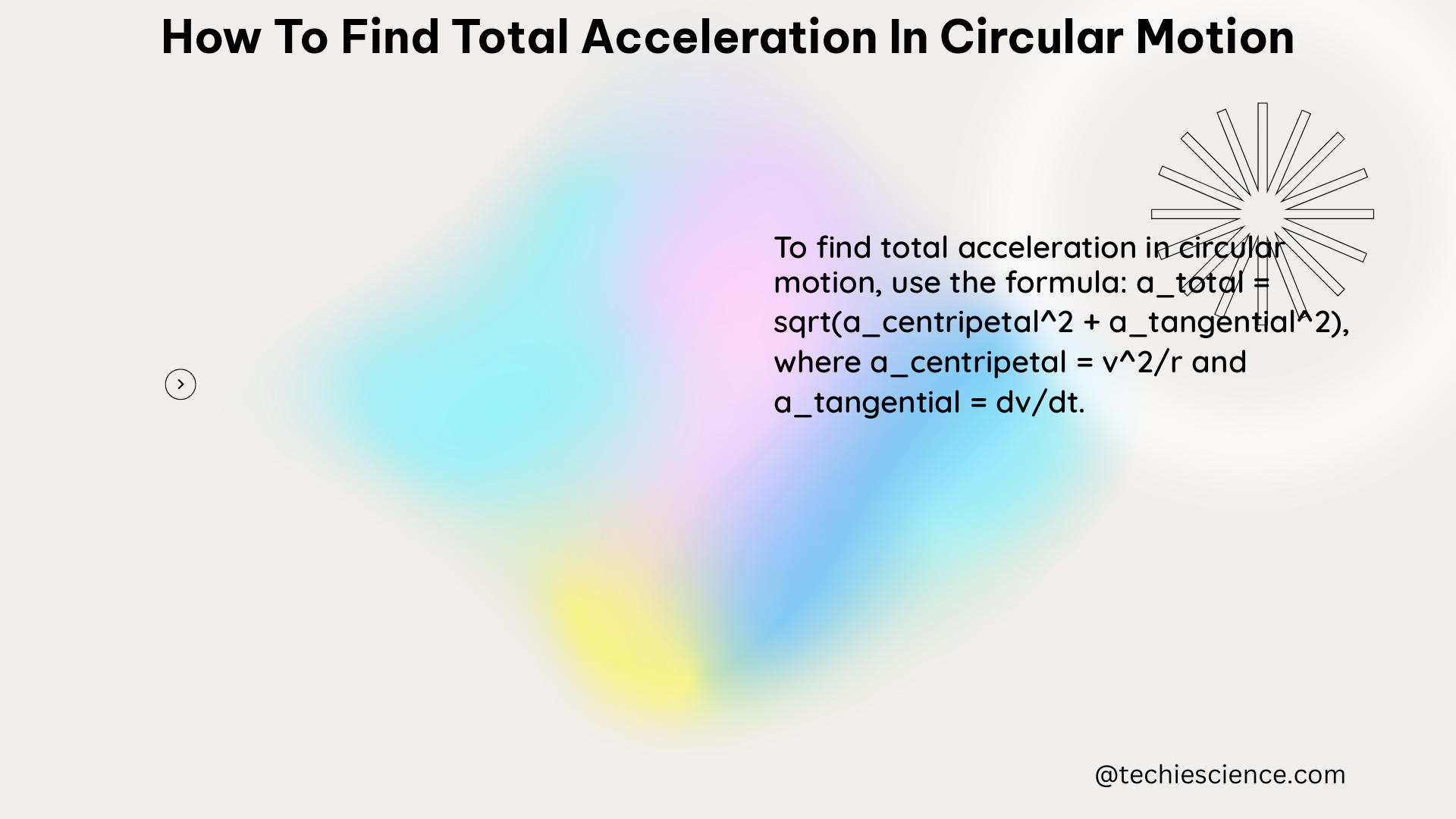In circular motion, the total acceleration experienced by an object is the vector sum of two components: the centripetal acceleration and the tangential acceleration. Understanding how to calculate these components and the overall total acceleration is crucial for analyzing the dynamics of objects moving in circular paths. This comprehensive guide will walk you through the step-by-step process of finding the total acceleration in circular motion, complete with examples, numerical problems, and relevant physics formulas.
Centripetal Acceleration
The centripetal acceleration, denoted as a_c, is the acceleration directed towards the center of the circular path. It is responsible for the object’s change in direction and is given by the formula:
a_c = v^2 / R
where:
– v is the velocity of the object
– R is the radius of the circular path
The centripetal acceleration is always directed towards the center of the circle and is perpendicular to the object’s velocity.
Tangential Acceleration

The tangential acceleration, denoted as a_t, is the acceleration in the direction tangent to the circular path. It is responsible for the object’s change in speed and is given by the formula:
a_t = dv/dt
where:
– dv/dt is the time rate of change of the velocity
The tangential acceleration can be in the same or opposite direction as the object’s velocity, depending on whether the speed is increasing or decreasing.
Total Acceleration
The total acceleration, denoted as a, is the vector sum of the centripetal acceleration and the tangential acceleration. It is calculated using the Pythagorean theorem:
a = √(a_c^2 + a_t^2)
The direction of the total acceleration can be determined using the following formula:
θ = tan^-1(a_t/a_c)
where θ is the angle between the total acceleration and the tangent to the circular path.
Example Problem
A car moves in a circle of radius r = 2.0 m. During the time interval from t = 1.5 s to t = 4.0 s, its speed varies with time according to v(t) = c_1 - c_2/t^2, where c_1 = 4.0 m/s and c_2 = 6.0 m·s. What is the total acceleration of the car at t = 2.0 s?
Strategy:
1. Calculate the centripetal acceleration using the formula a_c = v^2 / R.
2. Find the tangential acceleration by taking the derivative of v(t) with respect to time and evaluating it at t = 2.0 s.
3. Use the Pythagorean theorem to find the total acceleration.
Solution:
1. Centripetal acceleration at t = 2.0 s:
a_c = (4.0 - 6.0/(2.0)^2) m/s = 2.5 m/s^2
The centripetal acceleration is directed towards the center of the circle.
-
Tangential acceleration:
a_t = dv/dt = 2c_2/t^3 = 2(6.0)/(2.0)^3 = 3.0 m/s^2
The tangential acceleration is in the direction of the motion. -
Total acceleration:
a = √(a_c^2 + a_t^2) = √(2.5^2 + 3.0^2) = 3.9 m/s^2
The total acceleration makes an angle ofθ = tan^-1(3.0/2.5) = 56°with the tangent to the circle.
Numerical Problem
A car moving in circles has both tangential and radial accelerations, and the total acceleration is the vector sum of the two. If the car is at the northernmost point on the circle, has a speed of 36 meters per second, and is slowing down at a rate of 1.20 meters per second squared, what is the magnitude of the acceleration of the car?
Strategy:
1. Calculate the radial acceleration using the formula a_c = v^2 / R.
2. Use the given tangential acceleration of 1.20 m/s^2.
3. Apply the Pythagorean theorem to find the total acceleration.
Solution:
1. Radial acceleration:
a_c = v^2 / R = (36 m/s)^2 / R = 0.90 m/s^2
-
Tangential acceleration:
a_t = -1.20 m/s^2(the car is slowing down) -
Total acceleration:
a = √(a_c^2 + a_t^2) = √(0.90^2 + (-1.20)^2) = 1.50 m/s^2
The magnitude of the total acceleration of the car is 1.50 meters per second squared.
Additional Resources
For further understanding and practice, here are some additional resources:
Remember, the key to mastering the concept of total acceleration in circular motion is to understand the underlying physics principles, practice solving various problems, and apply the formulas correctly. With this comprehensive guide, you should be well on your way to becoming an expert in this topic.
Reference:

The lambdageeks.com Core SME Team is a group of experienced subject matter experts from diverse scientific and technical fields including Physics, Chemistry, Technology,Electronics & Electrical Engineering, Automotive, Mechanical Engineering. Our team collaborates to create high-quality, well-researched articles on a wide range of science and technology topics for the lambdageeks.com website.
All Our Senior SME are having more than 7 Years of experience in the respective fields . They are either Working Industry Professionals or assocaited With different Universities. Refer Our Authors Page to get to know About our Core SMEs.